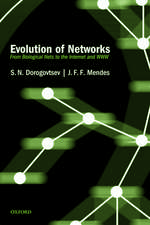Architecture of Systems Problem Solving: IFSR International Series in Systems Science and Systems Engineering, cartea 21
Autor George J. Klir, Doug Eliasen Limba Engleză Paperback – 14 sep 2012
| Toate formatele și edițiile | Preț | Express |
|---|---|---|
| Paperback (1) | 643.84 lei 6-8 săpt. | |
| Springer Us – 14 sep 2012 | 643.84 lei 6-8 săpt. | |
| Hardback (1) | 652.17 lei 6-8 săpt. | |
| Springer Us – 31 ian 2003 | 652.17 lei 6-8 săpt. |
Din seria IFSR International Series in Systems Science and Systems Engineering
- 18%
 Preț: 955.70 lei
Preț: 955.70 lei - 18%
 Preț: 951.91 lei
Preț: 951.91 lei - 18%
 Preț: 1391.21 lei
Preț: 1391.21 lei - 18%
 Preț: 955.56 lei
Preț: 955.56 lei -
 Preț: 387.58 lei
Preț: 387.58 lei - 20%
 Preț: 994.73 lei
Preț: 994.73 lei - 18%
 Preț: 1132.33 lei
Preț: 1132.33 lei - 15%
 Preț: 637.59 lei
Preț: 637.59 lei - 15%
 Preț: 640.24 lei
Preț: 640.24 lei - 20%
 Preț: 989.79 lei
Preț: 989.79 lei - 18%
 Preț: 947.67 lei
Preț: 947.67 lei - 18%
 Preț: 953.03 lei
Preț: 953.03 lei -
 Preț: 386.61 lei
Preț: 386.61 lei - 18%
 Preț: 1109.92 lei
Preț: 1109.92 lei - 20%
 Preț: 501.43 lei
Preț: 501.43 lei - 18%
 Preț: 1116.26 lei
Preț: 1116.26 lei -
 Preț: 399.29 lei
Preț: 399.29 lei - 20%
 Preț: 644.48 lei
Preț: 644.48 lei -
 Preț: 391.40 lei
Preț: 391.40 lei - 15%
 Preț: 646.62 lei
Preț: 646.62 lei - 19%
 Preț: 447.27 lei
Preț: 447.27 lei -
 Preț: 388.52 lei
Preț: 388.52 lei - 18%
 Preț: 792.03 lei
Preț: 792.03 lei - 15%
 Preț: 648.42 lei
Preț: 648.42 lei - 18%
 Preț: 786.36 lei
Preț: 786.36 lei -
 Preț: 520.08 lei
Preț: 520.08 lei - 15%
 Preț: 643.00 lei
Preț: 643.00 lei
Preț: 643.84 lei
Preț vechi: 757.46 lei
-15% Nou
Puncte Express: 966
Preț estimativ în valută:
123.21€ • 133.79$ • 103.50£
123.21€ • 133.79$ • 103.50£
Carte tipărită la comandă
Livrare economică 22 aprilie-06 mai
Preluare comenzi: 021 569.72.76
Specificații
ISBN-13: 9781461348467
ISBN-10: 1461348463
Pagini: 368
Ilustrații: XV, 349 p.
Dimensiuni: 155 x 235 x 19 mm
Greutate: 0.51 kg
Ediția:Softcover reprint of the original 2nd ed. 2003
Editura: Springer Us
Colecția Springer
Seria IFSR International Series in Systems Science and Systems Engineering
Locul publicării:New York, NY, United States
ISBN-10: 1461348463
Pagini: 368
Ilustrații: XV, 349 p.
Dimensiuni: 155 x 235 x 19 mm
Greutate: 0.51 kg
Ediția:Softcover reprint of the original 2nd ed. 2003
Editura: Springer Us
Colecția Springer
Seria IFSR International Series in Systems Science and Systems Engineering
Locul publicării:New York, NY, United States
Public țintă
ResearchCuprins
1 Introduction.- 1.1 Systems Science.- 1.2 Systems Problem Solving.- 1.3 Hierarchy of Epistemological Levels of Systems.- 1.4 The Role of Mathematics.- 1.5 The Role of Computer Technology.- 1.6 Architecture of Systems Problem Solving.- 2 Source and Data Systems.- 2.1 Objects and Object Systems.- 2.2 Variables and Supports.- 2.3 Methodological Distinctions.- 2.4 Discrete versus Continuous.- 2.5 Image Systems and Source Systems.- 2.6 Data Systems.- 3 Generative Systems.- 3.1 Empirical Investigation.- 3.2 Behavior Systems.- 3.3 Methodological Distinctions.- 3.4 From Data Systems to Behavior Systems.- 3.5 Measures of Uncertainty.- 3.6 Search for Admissible Behavior Systems.- 3.7 State-Transition Systems.- 3.8 Generative Systems.- 3.9 Simplification of Generative Systems.- 3.10 Systems Inquiry and Systems Design.- 4 Structure Systems.- 4.1 Wholes and Parts.- 4.2 Systems, Subsystems, Supersystems.- 4.3 Structure Source Systems and Structure Data Systems.- 4.4 Structure Behavior Systems.- 4.5 Problems of Systems Design.- 4.6 Identification Problem.- 4.7 Reconstruction Problem.- 4.8 Reconstructability Analysis.- 4.9 Simulation Experiments.- 4.10 Inductive Reasoning.- 4.11 Inconsistent Structure Systems.- 5 Metasystems.- 5.1 Change versus Invariance.- 5.2 Primary and Secondary Systems Traits.- 5.3 Metasystems.- 5.4 Metasystems versus Structure Systems.- 5.5 Multilevel Metasystems.- 5.6 Identification of Change.- 6 GSPS: Architecture, Use, Evolution.- 6.1 Epistemological Hierarchy of Systems : Formal Definition.- 6.2 Methodological Distinctions: A Summary.- 6.3 Problem Requirements.- 6.4 Systems Problems.- 6.5 GSPS Conceptual Framework: Formal Definition.- 6.6 Overview of GSPS Architecture.- 6.7 GSPS Use: Some Case Studies.- 6.8 GSPS Evolution.- Author Index.
Caracteristici
Presents and deconstructs the fundamentals of an expert system and many associated examples Structures as an interdisciplinary that meets the needs of both systems science and engineering students Provides students with a broad base and promotes more in-depth study of the topic Researchers and practitioners benefit from discussion of tools and underdeveloped areas of research Valuable reference text for designers of expert systems











